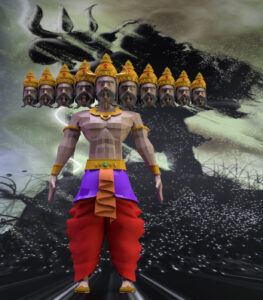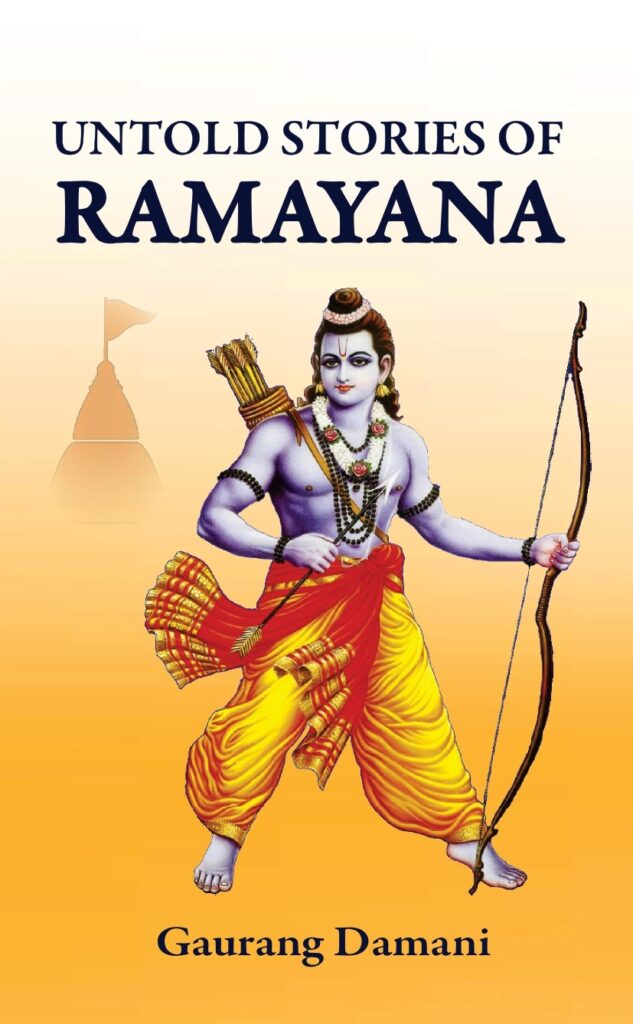
Ravana worshipped God Shiva for a boon at Mount Kailasha in present-day Tibet. When God Shiva did not appear, Ravana moved to a grove south of the Himalayas. He performed severe penances. He started to cut his head one after another to appease God Shiva. When he was about to cut his 10th head, God Shiva appeared as a jyotirlinga (celestial light) to grant a boon. Ravana asked for unparalleled strength. God Shiva restored his 9 heads like a vaidya (physician) and granted him the requested boon. This was at present-day Vaidyanath jyotirlinga temple in Deoghar of Jharkhand state. There are other locations also associated with this legend.
Ravana also asked for God Shiva’s Atma-linga which was in Kailasha, to be taken to Lanka. God Shiva was a little disinclined as the all-powerful Atma-linga would grant more powers to the wicked Rakshasa. Being a Bhole natha (guileless God), he permitted Ravana to carry it. But God Shiva said the Atma-linga will remain rooted forever wherever placed on the ground.
While carrying the Atma-linga, Ravana felt a tremendous urge to urinate due to God Shiva’s powers of maya (delusion). Ravana saw a young cowherd and asked him to hold the Atma-linga while he completed the job, which took quite a long time.
As per popular folklore, the cowherd was God Ganesha in disguise. This incident happened at the present-day Gola Gokarannath temple in Uttar Pradesh state, which has a Ravan-kund nearby.
The cowherd ran away with the Atma-linga, with Ravana in pursuit. Further, God Vishnu clouded the sun, so that Ravana would stop for his sandhya vandana evening prayers. Later, the cowherd called out Ravana 3 times as pre-decided and put down the heavy Atma-linga. The furious Ravana hit out at the boy. God Ganesha appeared in his true form. Ravana apologized. He then tried his best to dislodge the Atma-linga but failed.
In present-day Gokarna in Karnataka state, there is an Atma-linga temple. There is a beautiful God Ganesha temple, right next to it. God Ganesha’s idol is in the form of a boy without the usual elephant face and has dent marks on the forehead.
It is pertinent to note that Mount Kailash, Gola Gokarannath and Gokarna are in a straight line on the map. Also, the Atma-linga’s uprooted parts fell at present-day Shejjeshwar, Dhareshwar, Gunavanteshwar, and Murdeshwar near Gokarna in Karnataka state.
Ravana returned to Lanka. The Deva-s (demigods) got worried that Ravana was now further invincible with the boon of unparalleled strength. They approached Devarishi Narada for help. Narada went to Lanka and told Ravana that he should lift Mount Kailasha to verify the efficacy of God Shiva’s boon. The stupid and ungrateful Ravana went to the home of his benefactor.
There at Mount Kailasha, the pushpaka vimana became motionless. Nandi, the bull vahana (vehicle) of God Shiva told Ravana not to proceed any further towards the holy abode. Ravana remarked with arrogance ‘Who is Shiva?’ and insulted Nandi by calling him a monkey. In turn, Nandi cursed Ravana that monkeys would destroy his race. Nandi added that he would provide excessive strength to the arms of monkeys.
Still proud of his unparalleled prowess, Ravana went on to lift the auspicious mountain causing it to shake. Parvati trembled and embraced her husband. God Shiva deemed that the arrogant Ravana’s end was near, and pressed the mountain with his toe. Out of terrible pain, Dashagreeva (the 10-headed Rakshasa) emitted a frightening scream that shook the world and thus got the epithet Ravana. Delighted in his mind, Narada returned to his abode. Ravana remained trapped under the mountain for 1,000 years. After singing praises and doing tapasya (penances) to please God Shiva, he was finally let off.
The wicked lustful Ravana was to meet a gory end at the hands of a human as destined by God Shiva. There is always someone mightier than the mighty.

This article is an excerpt from the book
‘Untold stories of Ramayana‘ by Gaurang Damani. The book is available on Padhega India and other online stores.
This article also appeared on the Hindu Post website
